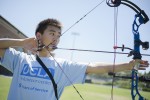Aim, cock back, shoot, repeat. Aim, cock back, shoot, repeat.
To the average bystander, archery looks pretty easy. There aren’t too many bodily movements involved in shooting and the targets are stationary.
As a matter of fact, most of the members of the UCLA archery club, which competed in the U.S. Intercollegiate Archery Championship over the weekend, started participating in archery for the first time this year.
“It’s one of those sports where if you put yourself into it, you can get pretty good pretty fast,” said fourth-year aerospace engineering student, and president of the UCLA archery club, Alan Chan. “A lot of our best archers started this year.”
But there is a catch. The average bystander may be able to become “good” at archery after a fairly short time, but taking the step from good to great can be a bit more challenging.
In what Chan calls a “game of millimeters,” the slightest fault in one’s shooting form can be the difference between hitting the center of the target and missing the target altogether.
“The thing you’re battling against the most is your own body,” Chan said. “The wind does hurt you, but when it comes down to it, if you’re not confident, and if you can’t hold the bow steady, then you’re going to lose more points than if the wind is blowing.”
With this slight margin for error in mind, an archer’s success is heavily dependent on mental confidence and focus on maintaining proper form. A few missed shots, and archers are no longer simply shooting at the target, they are battling their own personal doubts.
Suddenly, archery isn’t so simple anymore.
“It’s similar (to an air ball in basketball),” Chan said. “And you say, did I miss that air ball because … maybe I just stepped wrong, or did I change my hand position, or was it just the fact that I’m just not good enough anymore.”
This year, second-year theater student Mark Royston, a first-year archer, had his initial encounter with the mental challenge of archery early on.
After he finished in last place in his division at the state indoor tournament in early January, Royston knew that something had to change.
“I started to realize that there was a lot more to (archery) than just showing up to practice and shooting an arrow,” he said. “You have to really be focusing the entire time. … It brought a whole new perspective on how I look at practices now.”
As Royston became increasingly focused during practice, he saw his archery skills improve drastically over a short period of time. He went from good to great, as he now ranks second nationally in the men’s basic bow division.
But there were times when Royston could have folded. Times when his mind could have gotten the better of him and taken him down.
At the West Regional Intercollegiate Archery Championships last month, Royston started off his bronze medal elimination match poorly, building a 4-0 deficit. In a match where the first archer to six points wins, Royston was feeling the pressure.
“I was shaking the entire time,” Royston said. “I was just not trying to get too upset, because once you allow yourself to get upset, there’s no coming back from it.”
Royston relied on his mental focus to mount a furious comeback and win the match to capture third place in the men’s basic bow division.
Now, Royston is noticing that the mental challenges of archery are helping him in other areas of life as well. He takes the focused mindset that he developed during archery into the theater, where he has seen himself improve as an actor.
“When you’re on stage, there’s just as much pressure as there is when you’re shooting (in) a tournament,” Royston said. “And it’s how you use that energy and that pressure, and put it into something constructive and useful.”
Similar to Royston, first-year English student Kimberly Wang is also seeing archery make an impact on her life in other areas.
When Wang first joined the archery team during winter quarter, she said she found it difficult to remain focused for long periods of time. But after several three-hour archery practices, Wang began to develop more mental stamina.
“In the beginning, I would be shooting fine and then toward maybe the hour mark, you could just see I’d be shooting all over the place,” Wang said. “I kind of worked at maintaining my concentration, maybe occasionally taking breaks and then trying to prolong that period in which I am focused.”
With many more three-hour practices under her belt, Wang says that it is now easier for her to remain focused not only on the archery field, but also when she reads long texts for her English classes.
“Three hours doesn’t seem so long anymore,” Wang said with a laugh.
As Wang and the other UCLA archers returned to the field after a short break from practice, their simultaneous action of shooting the bow-and-arrow at a row of targets resumed once again.
The actions of archery still looked fairly simple, but the minds of the archers were working well beyond measure.
